
To understand what is the current Second Life experience, we conducted user studies with four types of users:
- Contextual Inquiries and Think Alouds were conducted with new Second Life users to understand what is their expectations of Second Life, what is their motivation for joining Second Life, and how they interact with the world and the community.
- Contextual Inquiries were conducted with expert Second Life users to learn how they compare to new users in the aforementioned characteristics.
- Interviewswere conducted with users who left Second Life to learn their opinions on virtual worlds and social networks, and why they left Second Life.
- Lastly, Contextual Inquiries were conducted with social networking experts to find out how they define themselves online, how they interact with others, and what attracts them to certain social networking services.
Surveys

Two hundred and ninety-three people responded to our survey. Among these respondents, 147 had experiences with Second Life, 117 had experience with virtual worlds, and 265 had experiences with social networking services. Within 147 Second Life users, 98 people identified their length of experiences: 64 people were in Second Life for more than one year, 12 people were on 6 months to a year, 13 people were on 1-6 months, and 8 people were on less than a month. The most important conclusions the surveys provided were:
- New users are interest in finding friends in-world, yet they do not spend much time on this activity.
- While experienced users enjoy groups and events, new users do not go to events, nor do they find groups easily or even see groups as valuable.
- A lack of real life contact information in Second Life profiles and many Residents' use of social networking accounts for their avatars suggest that anonymity is very important to Residents.
While the majority of people left Second life early on, the people who remained began to use Second Life more frequently; after three years of experience with Second Life, 50% used it multiple times a day. In contrast, people who used other virtual worlds were increasingly likely to leave as time passed, and by three years or so, 75% of people no longer used the same virtual world.
Most Residents were less comfortable communicating outside of Second Life, while brand new users were not comfortable with keeping in touch with other Residents in general. Residents were not very comfortable with adding their contact information in their profile, and rarely do Residents include their real life name on their profile.
The overwhelmingly top reason Second Life Residents went in-world was to hang out with their friends. New users log on mainly to explore, make new friends, earn Linden Dollars and shop for their avatars. Expert users manage businesses and attend events.
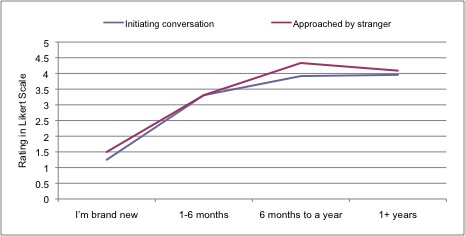
Comfort talking with strangers on a 5-point Likert scale
While brand new and relatively new users responded that they go in-world to find new friends, they do not spend much time on this activity itself, with no relatively new respondents citing this and being the second to last popular activity amongst brand new users. However, by the time users reach 1-6 months of usage, they do not mind chatting with strangers, and this occurs most often when strangers are near them.
In addition to socializing, Second Life Residents enjoyed attending events as well. Yet nearly half of the people who had been using Second Life less than half a year said they had never attended an event. When we asked those who enjoy events who they find these events, we found that people with less experience used the search tool while people with a year or more experience mainly used groups and word of mouth.
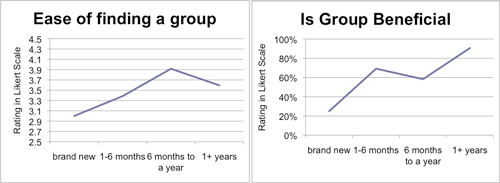
Ease of finding a group and perceived group benefit
Being that those who had been Residents for an extended period of time preferred groups as a good source of event information, we looked into how accessible groups were for Residents. We found that new users do not find it easy to discover a group that interests them, nor do they find it beneficial to do so. An explanation of this is pursued in our interviews.
Interviews
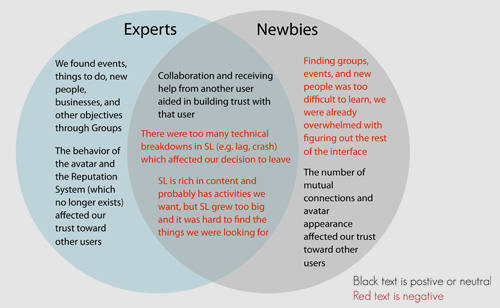
We focused on exploring the opinions and specific experiences of users who left Second Life. We interviewed two expert users who left and two novice users who left. Some key similarities and differences between expert and novice users were:
- In meeting another resident, the participants looked to the appearance of the avatarm his or her behavior and activities, along with the general chemistry of the conversation, particularly sense of humor, when judging if someone was trustworthy. Experts especially said that there was no set rule in deciding whether a Resident was trustworthy.
- Expert users found events, things to do, new people, businesses, and other objectives through Groups, while novices were overwhelmed by the interface and gave up because of the difficulty of finding such things
- Both experts and novices agreed that collaborating and receiving help from another user aided in building trust with that user.
- All users made their decision to leave partially based on the lags and crashes they frequently experienced with Second Life
- Both experts and novices acknowledge that Second Life is rich in content, but that it grew too big which made it hard to find things they were looking for
Contextual Inquiry of Social Networking Experts

We conducted Contextual Inquiries with two social network experts to reveal how people use social networks to shape their virtual identity, how they manage their friends across different social networks, and what is attractive about additional social networks. An expert is defined as a person who uses multiple social network services actively. Some major findings were:
- Multiple levels of privacy options are needed to serve a diverse variety of users
- Users use different social network accounts are used for different audiences and purposes, similar to Second Life users who have multiple avatars
- Friend verification is an important step to ensure the integrity of the user's social network, avoiding weak connections that may downgrade such a network's value to the user
- Restricting access to the user's profile, and taking steps to verify friends ahs the added benefit of decreasing the amount of spam the user encounters, benefitting his or her overall experience.
- Users enjoy object-centered content as a way to check in with friends, a feature that can be well supported within Second Life
Contextual Inquiry of Second Life Experts
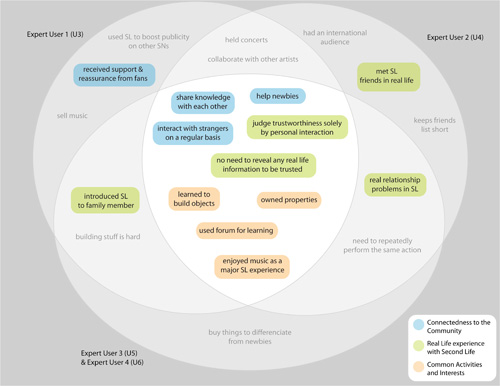
We conducted three Contextual Inquiries with four Second Life expert users to learn what motivates users to remain active in Second Life. We defined expert users as those who have been active in Second Life for more than a year and log on daily. Of our four participants, two performed music in Second Life on a regular basis, while the other two reported listening to music and dancing as their primary activities in Second Life. After consolidating the Workflow and Cultural models for all four experts, some common themes across all of the experts' usage of Second Life surfaced:
- Experts were well-connected to their surrounding communities. They shared knowledge with their friends and interactive with strangers on a regular basis
- Expert users had real life friends who were also on Second Life, or have interacted with Second Life friends in real life. They said that there is no concrete rule for judging if a Resident is genuine, and that a Resident does not ned to reveal any real life information to be trusted
- Music is a major part of all the experts' Second Life experiences
- All of the participants had owned properties at some point in their Second Life, if not currently, and have learned how to construct objects. They had employed forums as one of the main places they looked for help in learning how to build in Second Life.
Contextual Inquiry and Think Alouds of Second Life Novices
We performed a Contextual Inquiry with a novice user by observing her in Second Life. In the one hour we observed, the user encountered 15 workflow breakdowns, 12 of which were identified as technical breakdowns. In terms of frequency, this averages to about one technical breakdown every five minutes. We found that the user simply accepted these issues as part of the Second Life experience. For this user, her benefits to using Second Life outweighed the cost of dealing with these technical issues because she was able to maintain a relationship on Second Life and felt strong emotional support from having this relationship.
Because of the difficulty gaining trust of novice users in Second Life, we were unable to conduct Contextual Inquiries with any other novice users. To supplement our knowledge of new users in Second Life, we conducted three Think Alouds with brand new users within Second Life.
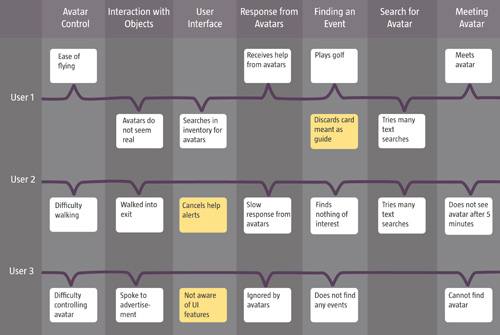
We performed Think Aloud studies with three new Second Life users. We gave the users three tasks:
- Find an activity in which to participate (other than avatar customization)
- Find an event that interests you
- Find a specific avatar in-world (with avatar name give)
- New users struggle with the smallest of actions, such as controlling the avatar, and this struggle continues into their attempts to explore the world. Even once they identified the correct feature to aid them in their intentions, they must further learn how this feature opertes, which is often in contrast to what they expect. Two out of three users did not get very far in finding things to do in Second Life in the roughly 40 minutes we observed them because much of their time was spent trying to learn the interface and features available at hand.
- Interacting with other Residents saves their experience, offering them guidance and making them feel more comfortable. However, all three users were frustrated by the lack of response from other avatars. One user was able to eventually obtain help from other avatars in learning how to play golf, which contributed to his positive experience.
- Only the user who seemed to grasp the "idea" of Second Life, that you can do anything you enjoy in real life in Second Life, enjoyed himself and expressed a desire to further explore the world.
Conclusions
An explanation of our combined findings from the user research phase can be found in the Findings page.